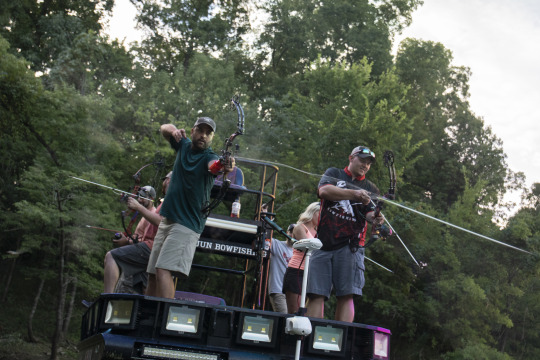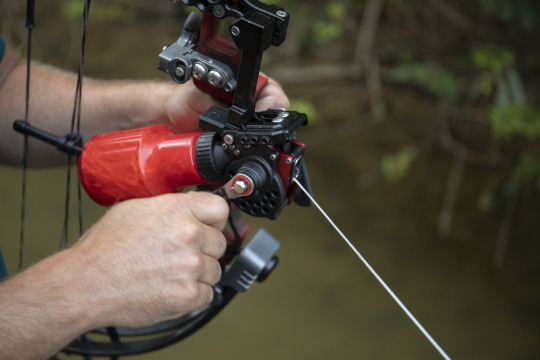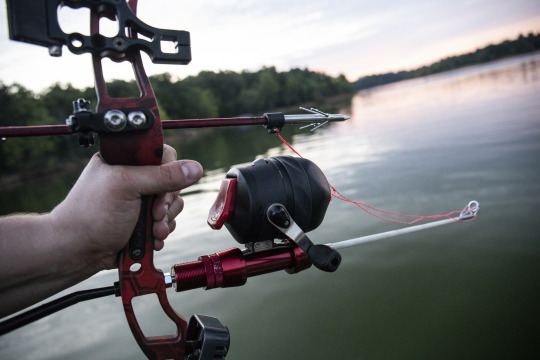At Cajun Bowfishing, we bowfish. If we aren’t comfortable using our products ourselves, why would you be? Our equipment is ruggedly field-tested to meet your highest standards.
Don't wanna be here? Send us removal request.
Text
3 Types of Bowfishing Reels and Picking the Best One for You
Whether you’re new to the bowfishing world or just in the market for a new reel, choosing the right bowfishing reel can be a little overwhelming. So how do you choose one that will best fit your needs? Follow the guidelines below to learn more about different bowfishing reels and find your go-to bowfishing reel for this spring.
First things first, there are three basic types of bowfishing reels; drum reels for hand retrieving, bottle style reels, and spin cast reels.

1. Screw-on Drum Reel or Hand Reel
The Screw-On Drum Reel from Cajun Bowfishing is the Original Gangster of bowfishing reels. This style has been around for many years. If you ever see a photo of Fred Bear bowfishing, chances are you will see that's what he is using. Why? Because of its simplicity and the traditional aspect of it. You will often see drum style reels on bowfishing recurves.
Pros of a Drum/Hand Reel:
- It's extremely simple and easy to use. Your bowfishing line is spooled around the drum and after your arrow is released, simply grab your line and wrap it around the reel again.
- These reels are budget-friendly and cost considerably less than any other style.
- Less moving parts. This reel is ultimately made up of the drum and a bolt that screws into the riser on your bow. This also means it's easier to clean and it really can't get out of working order.
Cons of a Drum/Hand Reel:
- The heavy line you need to use on hand reels can prevent your arrow from flying as far, especially if you're bowfishing with a traditional bow.
- Pulling in a heavy fish by hand can put wear and tear on your skin. Trust me, I have scars to prove it. If you're shooting big fish, gloves are a must with these reels.
- You can't reel in quickly for a backup shot. Since you're grabbing the string by hand, it can be a bit slower than other types of reels.

2. Bottle reel or winch style reel
This is a very popular type of reel and it can hold its own in the bottle vs spincast reel debate. This reel encloses your line in a bottle and has a handle you turn to reel in your line. The Winch Pro Reel from Cajun Bowfishing features a Fighting Wheel Brake allowing you to brake and reel simultaneously to better reel in those river monsters. I have used this type of bowfishing reel many times over the years.
Pros of a Bottle Reel:
- Very sturdy, these reels can withstand pretty much anything.
- The enclosed line in the bottle makes it harder to get tangles, but if you DO get a tangle, the bottle is easy to remove.
- These reels can withstand the dirt, mud or sand that comes with the bowfishing territory.
Cons of a Bottle Reel:
- These reels aren't designed to be reeled in with big fish on the other end, so often you may be grabbing line by hand.
- Similar to the hand reels, you will be using heavier line. I've noticed it can be a bit more difficult to make distance shots because of it.
- More moving parts. Although bottle reels are generally easy to use once you get the hang of it, there can be a bit of a learning curve in the beginning.

3. Spincast Reel
This type of reel is extremely popular in the tournament world of bowfishing and is my favorite type of reel. The spincast reel looks like an enlarged fishing reel that mounts onto your bow. A great option is the Cajun Spin Doctor reel. Simply push the button to release the line and crank the handle to reel it in.
Pros of a spincast reel:
- You can shoot and retrieve faster than other reels. The lighter line lets you take farther shots more accurately.
- If you've used a fishing reel, you can operate this.
- When using with a Reel Seat (purchased separately), it's easy to take the reel off and on your bow for cleaning and replacing the line.
Cons of a spincast reel:
- These reels can get dirty quickly, especially if you're shooting in an area with a lot of sand. You will need to take your reel apart and clean it about once or twice a year, depending on how often you shoot.
- Spincast reels use a thinner line compared to the line used with the other two types of reels. Although the line is tough, you should check it regularly for frayed spots as gar teeth and dragging the line across rocks can create weak points in the line.
- Big and heavy fish can strip the gears if you reel in too quickly. I learned that with this type of reel you will often have to "play" a heavy fish a bit to get it into you.
Honestly, whichever you choose, there is no wrong answer. I have used all of them with success! Now that you understand which type of reel will work best for your style of bowfishing it’s time to get out there and start reeling in those big fish!
About the Author:
Born and raised in New Jersey, Beka Garris grew up hunting, fishing, and farming and continues to lead an avid outdoor lifestyle on her farm in Ohio. When she’s not shooting her longbow or shooting fish, she’s sharing her passions with her audiences through her social media pages, blog, and cookbook.

2 notes
·
View notes
Text

With February now over, spring is just around the corner which means our favorite season is just beyond the horizon. Despite the frozen waters and frigid temperatures that many of us have experienced this winter, now is the time to prepare for the upcoming bowfishing season!
Here are 5 things you can do NOW to prepare for your next bowfishing adventure:
1. Clean your equipment. Each time you put your bow down to pull in that big fish, you’re more likely to get mud and dirt caked all over and inside your equipment (think of the cams on your bow and around your arrow rest). If it stays cemented in there over a long period of time, your equipment may not perform as needed. Also, make sure your bowstring is waxed and there are no fraying points.
2. Check for broken equipment. Looking to upgrade this season? Now is the time to do it. Rests, in particular, can wear out quickly so if you're in the market for a new one, check out the new Brush Fire Arrow Rest released last spring from Cajun Bowfishing.
3. Buy or renew your fishing license. This is something that's easy to forget and many expire at the beginning of a new year. Rules and regulations can vary from state to state.
4. Inspect arrows for cracks. This one can be crucial because the last thing you want when you’re out on the water having a good time is a fiberglass arrow exploding or splintering and injuring you.
5. Start scouting now. Even if the water is still frozen, it’s helpful to go check out different areas, especially if you haven't been there since last season. Every year our rivers and creeks change slightly, and so I take note of those changes when scouting for the next bowfishing honey hole. Another bowfishing scouting tip, pay attention to any new trees that have fallen in the water, fish like to hide in these trees and it will most likely be a new hot spot for prime stik’n time.

It’s always good to be prepared so when spring finally arrives you’re ready to start stik’n those fish!
What do you like to do to prepare for your bowfishing season? Let us know in the comments.
About the Author
Born and raised in New Jersey, Beka Garris grew up hunting, fishing, and farming and continues to lead an avid outdoor lifestyle on her farm in Ohio. When she’s not shooting her longbow or shooting fish, she’s sharing her passions with her audiences through her social media pages, blog, and cookbook.

1 note
·
View note
Text
Cajun Pro-Staffer Brandonn Kramer’s Black Buffalo Breaks Michigan Record
It was a quiet, uneventful night for Brandonn Kramer and Shawn Grawbarger as they floated on the Grand River in Ottawa County, Michigan, searching for their next bowfishing target.
The two were just about to turn on their large motor and head to another location when they noticed the clear water that once resided under their boat turned murky.
Brandonn caught a glimpse of a large black buffalo right on the edge of the mud cloud and told Shawn to get ready.

“It was actually kind of a fluke,” Brandonn, the Cajun Bowfishing Pro-Staffer of five seasons, said. “I knew what kind of fish it was when I aimed, but I didn’t realize it was so large.”
Brandonn fought the river monster with his reel as it attempted to hide in the thick grass beneath his boat.
When the two anglers finally pulled the black buffalo into their boat, they were amazed by its size and immediately took to shore to investigate.
The fish, weighing in at 46.54 pounds and measuring 39.75 inches, was officially confirmed as the new Michigan black buffalo record by Jay Wesley, Michigan Department of Natural Resources Fisheries Manager for the DNR’s Lake Michigan Basin.
The average length of a Black Buffalo is 20 to 30 inches while the average weight is estimated to be about 10 to 30 pounds. They are found primarily in both small and large rivers in the basins of the Mississippi, Missouri, and Ohio as well as in southern Lake Michigan and Lake Erie.
It’s not hard to notice a buffalo fish – but deciphering which kind can be tricky. The body of a Black Buffalo is thicker than that of a Smallmouth Buffalo, but not as deep. Its coloring, a deep olive tone, is similar to the Bigmouth Buffalo, but a little darker.
The previous record-holder was also caught in the Grand River in Ottawa County by Sage Colegrove on April 12, 2015. That fish weighed 44.54 pounds and measured 38.5 inches.
“That catch completely turned our slow night around,” Brandonn said. “We ended up going back out on the river and staying there for two more hours to see what else we could find.”
Brandonn was contemplating mounting his catch when he was contacted by Alec Lackmann, a Ph.D. candidate from North Dakota State University who is working on a project pertaining to all species of buffalo fish.
Brandonn donated his fish to the student who is now working on aging the fish and comparing it to the bigmouth buffalo, a fish he primarily researches.
The gear Brandonn used to score the record-breaker includes the Cajun Sucker Punch bow, Spin Doctor Reel, Biscuit Arrow Rest and Piranha Point.
If you want a chance at catching your state’s next record breaker, visit cajunbowfishing.com to stock up on everything you need.
1 note
·
View note
Text
Father’s Day Bowfishing Gift Guide
If your dad is looking to branch out and try something new this summer, why not test the waters with a bowfishing Father’s Day gift? Bowfishing is a fun, perfect escape from the daily grind. Check out our list of gift ideas and find the perfect bowfishing gift for dad.

Cajun Bowfishing Sucker Punch Bow
Light and perfectly balanced with 50-pound peak draw interchangeable draw modules, adjustable draw length, and 60% draw-specific let off, it provides smooth, easy shooting. The specialized Sucker Punch looks, feels, and shoots like it was made for you alone, built for times when you answer to yourself.
MSRP: $309.99

Cajun Bowfishing Brush Fire Arrow Rest
The Brush Fire is the all-new Cajun Bowfishing arrow rest with a Teflon impregnated insert on bottom for durability and replaceable bristles for full containment. The Brush Fire features an aluminum body, windage adjustments, and laser-engraved reference marks.
MSRP: $29.99

Cajun Winch Pro Bowfishing Reel
Bowfishing is an unforgiving exertion that taxes equipment under intense conditions. The Winch Pro takes the punishment and keeps asking for more. The all new Winch Pro introduces a revolutionary design that allows the ability to brake and reel simultaneously to better bring in monsters up from the depths day after day or night after night.
MSRP: $129.99

Cajun Spin Doctor Reel
The all-new and improved Cajun Spin Doctor Reel is the most durable and innovative spincast bowfishing reel on the market. The reel is designed to endure the rigors of the sport with dual pickup pins with full metal assembly and a longer hood and larger hole design for better line feeding. If you’re wanting to purchase a spincast reel, don’t forget to add a reel seat mount!
MSRP: $59.99
#cajunbowfishing#bowfishing#spinreel#fishing#archery#fathersday#gift#giftideas#giftguide#bow fishing#startstikn
1 note
·
View note
Text
Bowfishing Trash Fish
I post a lot about bowfishing to my social media pages. It’s one of my favorite summer activities. So of course one of the questions I am asked the most is, “What do you do with the fish you shoot?”

Some of the people posing this question are anti-hunting and anti-bowfishing. But the majority are simply people who want to know whether or not there is actually anything useful that can be done with the hundreds of fish that are being shot — besides tossing them in a ditch and calling it a day.
Sure, you can dump them or toss them. Just make sure it’s an area away from walking paths or boat ramps. If someone decides to take their morning jog along the river and stumbles onto a pile of rotting fish, odds are they’re going to make a complaint. With enough complaints, your area will start posting no bowfishing signs and there won’t be any more fun.
Here are a few alternatives to consider:

You can eat them. Yes, you read that correctly. Most people think “trash fish” and automatically turn up their noses at the idea of any of these fish being edible. Although there are a few species I am not fond of (common carp — yuck), and don’t take the time to filet and eat, there are several species that are very good to eat. Where I live in Ohio, these species include gar, buffalo, and suckers. (We can’t shoot catfish here.)
Although the gar are a bit more work to clean, they are well worth it. Gar have two long narrow strips of meat along their backbone, similar to backstraps on a deer. There are no bones in it, and it is a firm white meat that actually tastes similar to chicken. Bread it and fry it right up with some dipping sauce.
Suckers are easily filleted in the same fashion you would filet a bass or pan fish, and are best made into fish patties or smoked. Although suckers have a good flavor, they are a bit bony which makes fish patties ideal. Cook the seasoned filets in a bit of butter in a frying pan until browned on both sides. (Browning it adds extra flavor!) Once cooked, the bones will be fairly easy to pick out and you are left with a pile of flaky meat. Add an egg, some parmesan cheese, bread crumbs, and some chives. Shape into patties and fry in oil until crisp. I like to make a dill sauce to go with it.
Give them away. Maybe you don’t like fish that much, or you don’t have the stomach to try rough fish. You can always give them to someone who does. When I first started bowfishing, I didn’t know anything about which species were good to eat. I would have many other fishermen come up to me and ask to if they could take the fish home and eat them, which I gladly obliged. Even now, on days I don’t feel like cleaning fish I will gladly give them to someone who wants them.
Bait. Carp, suckers, quillback, and shad make great cut bait for catfishing or if you’re turtle trapping. I used to fill garbage cans with carp to give to a local turtle trapper and the snapping turtles love it. You can use the fish for trapping bait, fishing bait, and hunting bait. A pile of dead carp will draw in plenty of coyotes, bears, raccoons, you name it. It’s a great way to bring in those coyotes that are bothering the neighbors’ sheep or eating the neighborhood cats.
Fertilizer. I think most of us can recall the story that we all read in grade school of how the pilgrims came to America and started their own colony. In the spring when they planted their crops, the Native Americans helped plant dead fish under the dirt to keep the soil rich and help their plants grow. Don’t believe it? Try it.
Sell them. Think of selling fish as getting paid to bowfish. You won’t get rich, but hey it’s something! Unbeknownst to most, there are plenty of game farms, zoos, and farmers that will pay you per pound for dead fish. Dead fish equals animal food! I know several people who actually make it into dog food, the cheapest organic dog food around. Reach out to some local places and you may soon be sponsored by a game farm or feeding the bears at your local zoo.
Do you have another solution to make use of the fish you shoot? Let us know in the comments!

#bowfishing#fishing#trashfish#fish#carp#cajun#cajunbowfishing#archery#riverfishing#bowfish#gar#garfish
1 note
·
View note